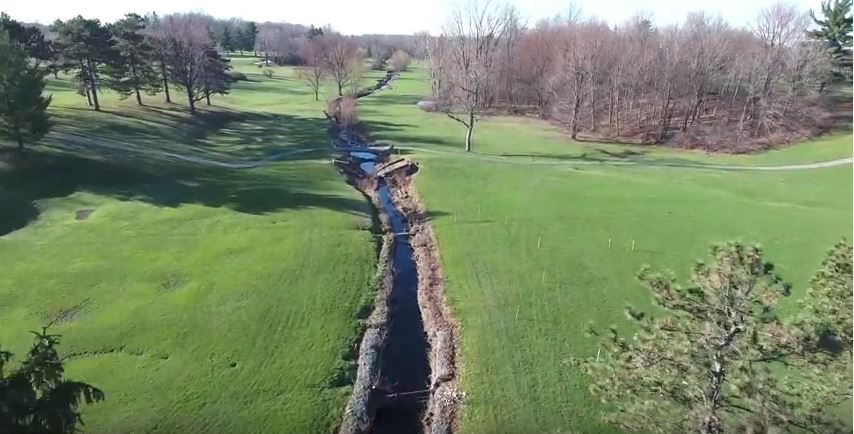The Northeast Ohio Regional Sewer District, in partnership with the City of Cleveland, and the West Creek Conservancy has acquired the land and funding for the restoration of a segment of Mill Creek within the Highland Park Golf Course, located in the Village of Highland Hills.
The project will stabilize and rehabilitate approximately 4,000 feet of the Mill Creek and will include creating more natural stream meanders and a hydraulically connected floodplain with wetland depressions. Failing stone walls and gabion baskets, which currently line the channel, will be removed and replaced with natural vegetated streambanks. A small dam will be removed and a pond currently filled with sediment will be returned to stream channel with a wetland floodplain. Exposed irrigation lines will be buried below the new channel, reducing future maintenance and costly repairs. Golf course drainage will be improved and the new stream channel will be integrated into the golf course to maintain course play.
Project funding:
$1,350,000 – Ohio EPA, Water Resource Restoration Sponsor Program
$257,000 – NEORSD Regional Stormwater Management Program
$92,400 – US Forest Service GLRI grant for native tree and shrub plantings


Check out these photos of the site in early May of 2016.

UPDATE December 2016
This large-scale habitat restoration began in March 2016 and was completed in November 2016.
Restoration measures included:
- Removing over 3,000 feet of failing stone and gabion walls
- Burying and protecting 19 irrigation line crossings under the stream bed
- Protecting one large water main crossing Mill Creek
- Removing 80 feet of storm culvert (stream daylighting)
- Partially removing a dam near the downstream end of the project
Project resulted in:
- Restoring 4,336 lineal feet of Mill Creek
- Restoring 180 lineal feet of a small tributaries to Mill Creek
- Reestablishing a vegetated floodplain and riparian area , which involved:
- Creating 6.6 acres of restored floodplain and 8.4 acres of upland vegetated buffer
- Planting a total of 540 trees, 1,500 shrubs and 960 herbaceous perennial plants
Approximately 4,600 live stakes, including 2,070 tree stakes will be planted along Mill Creek in November 2016.
The project was designed and constructed with grant money from the Ohio EPA’s Water Resource Restoration Sponsor Program Funding ($1.35 Million dollars), $257,000 from the Northeast Ohio Regional Sewer District’s Regional Stormwater Management Program, and an additional $97,400 Great Lakes Restoration Initiative Grant from the US Forest Service for tree and shrub plantings (obtained by West Creek Conservancy).
Along with habitat, aesthetic and water quality benefits provided by this project, modeling with i-Tree software applications indicates that the revegetated floodplain will soak up over 3.2 million gallons of stormwater annually at maturity. Similarly, the hydraulic model suggests that the peak discharge downstream for smaller storm events will be delayed by 17 minutes due to the restored stream and floodplain. These results provide evidence that over time the value of the services provided by the restored stream and floodplain will more than pay for the design and engineering costs on this very large project.
Experts from the Northeast Ohio Regional Sewer District and partners helped plant vegetation to stabilize stream banks over the summer, and here they explain a bit about the project.
Here’s a birds-eye view of the finished project:
A WATERSHED SUCCESS STORY September 2017
Riparian Restoration of Mill Creek in Ohio
Mill Creek within the Highland Park Golf Course was degraded and eroding as a result of high-velocity urban stormwater runoff. Golf course infrastructure was being threatened and the stream could not access its floodplain where high flows are typically slowed and pollutants are absorbed. In the highly urbanized area surrounding this segment of Mill Creek, the Northeast Ohio Regional Sewer District and the City of Cleveland saw an opportunity to restore the stream and floodplain, and use this valuable green space to correct the damage caused by urban stormwater.
In September 2017, the USDA Forest Service Northeastern Area State and Private Forestry found the Mill Creek restoration a worthy example of how technical and financial assistance improves forest health and increases community vitality, and deemed the project A Watershed Success Story.
Read the USDA Forest Service’s Mill Creek story and other State and Private Forestry Success Stories.
Learn more about the restoration of Mill Creek in the articles and videos posted above this section.


